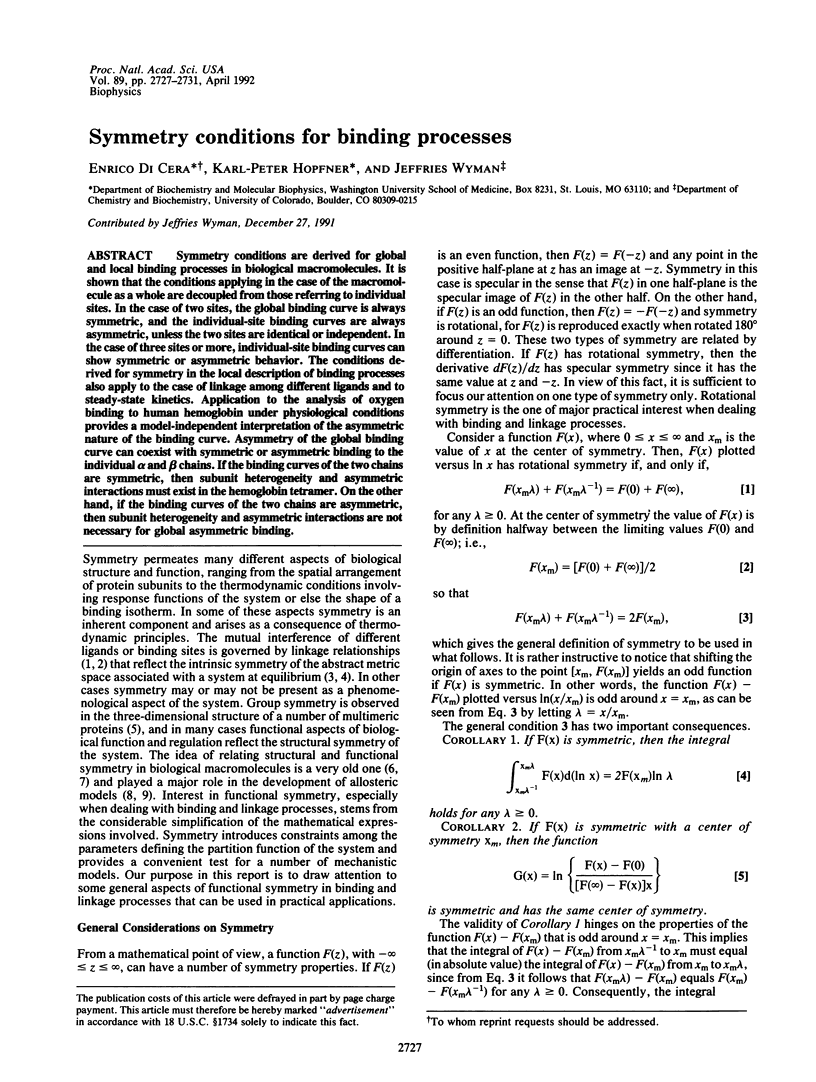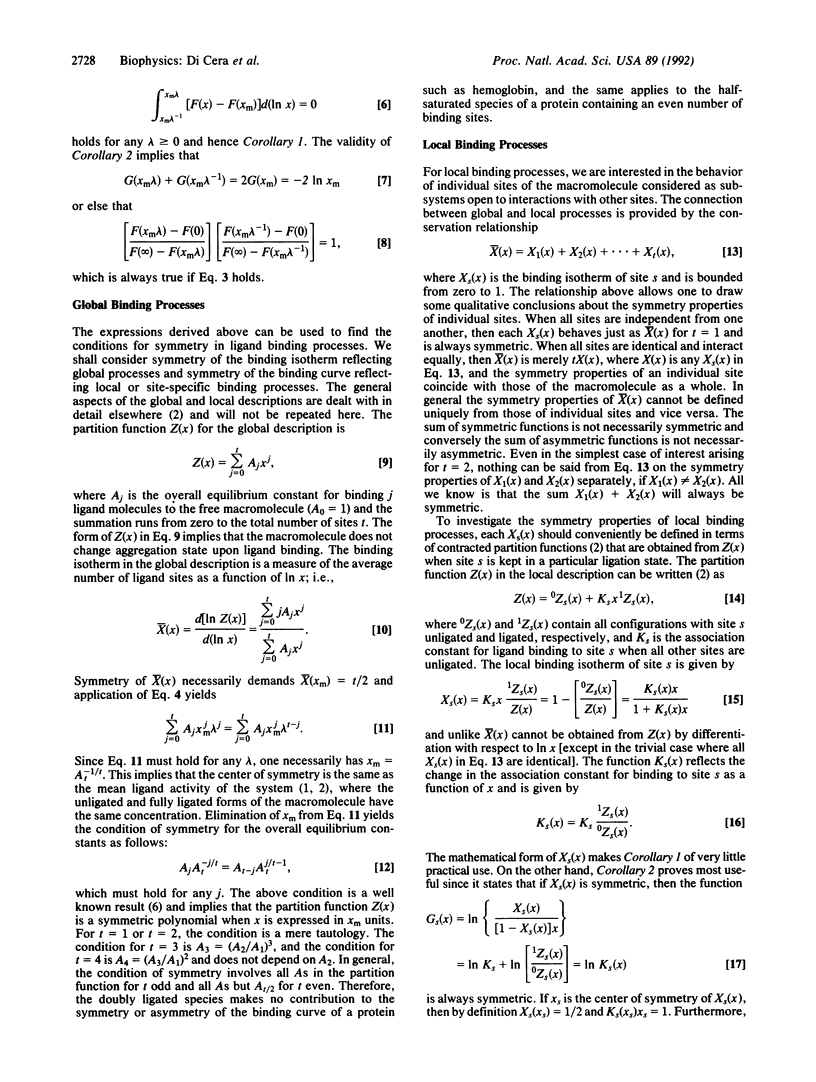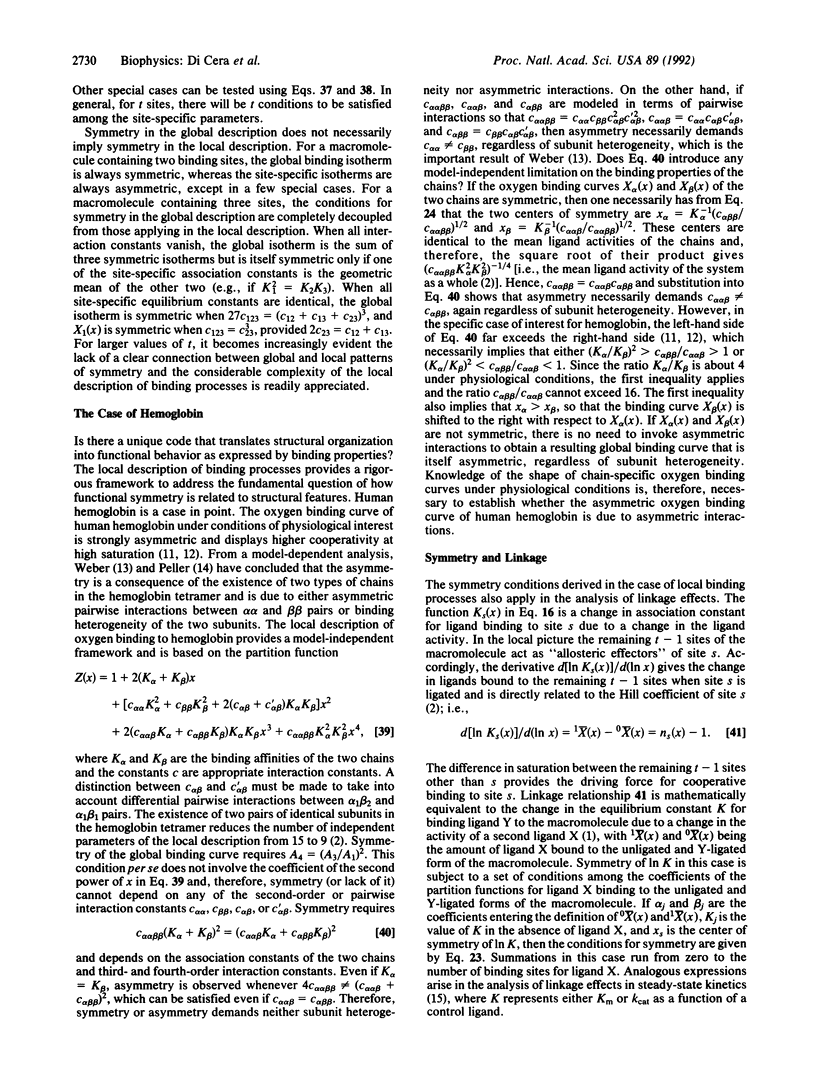Abstract
Symmetry conditions are derived for global and local binding processes in biological macromolecules. It is shown that the conditions applying in the case of the macromolecule as a whole are decoupled from those referring to individual sites. In the case of two sites, the global binding curve is always symmetric, and the individual-site binding curves are always asymmetric, unless the two sites are identical or independent. In the case of three sites or more, individual-site binding curves can show symmetric or asymmetric behavior. The conditions derived for symmetry in the local description of binding processes also apply to the case of linkage among different ligands and to steady-state kinetics. Application to the analysis of oxygen binding to human hemoglobin under physiological conditions provides a model-independent interpretation of the asymmetric nature of the binding curve. Asymmetry of the global binding curve can coexist with symmetric or asymmetric binding to the individual alpha and beta chains. If the binding curves of the two chains are symmetric, then subunit heterogeneity and asymmetric interactions must exist in the hemoglobin tetramer. On the other hand, if the binding curves of the two chains are asymmetric, then subunit heterogeneity and asymmetric interactions are not necessary for global asymmetric binding.
Full text
PDF




Selected References
These references are in PubMed. This may not be the complete list of references from this article.
- De Cristofaro R., Di Cera E. Effect of protons on the amidase activity of human alpha-thrombin. Analysis in terms of a general linkage scheme. J Mol Biol. 1990 Dec 20;216(4):1077–1085. doi: 10.1016/s0022-2836(99)80021-7. [DOI] [PubMed] [Google Scholar]
- Di Cera E., Doyle M. L., Morgan M. S., De Cristofaro R., Landolfi R., Bizzi B., Castagnola M., Gill S. J. Carbon monoxide and oxygen binding to human hemoglobin F0. Biochemistry. 1989 Mar 21;28(6):2631–2638. doi: 10.1021/bi00432a041. [DOI] [PubMed] [Google Scholar]
- Di Cera E. Thermodynamics of local linkage effects. Contracted partition functions and the analysis of site-specific energetics. Biophys Chem. 1990 Aug 31;37(1-3):147–164. doi: 10.1016/0301-4622(90)88015-k. [DOI] [PubMed] [Google Scholar]
- Di Cera E., Wyman J. Global and local metric geometry of ligand binding thermodynamics. Proc Natl Acad Sci U S A. 1991 Apr 15;88(8):3494–3497. doi: 10.1073/pnas.88.8.3494. [DOI] [PMC free article] [PubMed] [Google Scholar]
- Koshland D. E., Jr, Némethy G., Filmer D. Comparison of experimental binding data and theoretical models in proteins containing subunits. Biochemistry. 1966 Jan;5(1):365–385. doi: 10.1021/bi00865a047. [DOI] [PubMed] [Google Scholar]
- MONOD J., WYMAN J., CHANGEUX J. P. ON THE NATURE OF ALLOSTERIC TRANSITIONS: A PLAUSIBLE MODEL. J Mol Biol. 1965 May;12:88–118. doi: 10.1016/s0022-2836(65)80285-6. [DOI] [PubMed] [Google Scholar]
- Pauling L. The Oxygen Equilibrium of Hemoglobin and Its Structural Interpretation. Proc Natl Acad Sci U S A. 1935 Apr;21(4):186–191. doi: 10.1073/pnas.21.4.186. [DOI] [PMC free article] [PubMed] [Google Scholar]
- Peller L. Cooperative deoxygenation of haemoglobin: asymmetry of binding and subunit differences. Nature. 1982 Dec 16;300(5893):661–662. doi: 10.1038/300661a0. [DOI] [PubMed] [Google Scholar]
- Perutz M. F. Mechanisms of cooperativity and allosteric regulation in proteins. Q Rev Biophys. 1989 May;22(2):139–237. doi: 10.1017/s0033583500003826. [DOI] [PubMed] [Google Scholar]
- ROUGHTON F. J., OTIS A. B., LYSTER R. L. The determination of the individual equilibrium constants of the four intermediate reactions between oxygen and sheep haemoglobin. Proc R Soc Lond B Biol Sci. 1955 Aug 16;144(914):29–54. doi: 10.1098/rspb.1955.0032. [DOI] [PubMed] [Google Scholar]
- WYMAN J., Jr LINKED FUNCTIONS AND RECIPROCAL EFFECTS IN HEMOGLOBIN: A SECOND LOOK. Adv Protein Chem. 1964;19:223–286. doi: 10.1016/s0065-3233(08)60190-4. [DOI] [PubMed] [Google Scholar]
- Weber G. Asymmetric ligand binding by haemoglobin. Nature. 1982 Dec 16;300(5893):603–607. doi: 10.1038/300603a0. [DOI] [PubMed] [Google Scholar]


